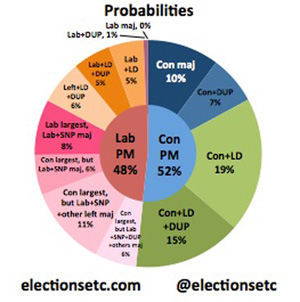The prime minister says he has 10 days to save the United Kingdom from the clutches of Nicola Sturgeon.
If the Tories don’t win an outright majority next week, Britain will end up with a weak Labour government propped up by the SNP, David Cameron said.
He thinks the nationalists, fresh from what polls suggest will be a rout of Labour in Scotland, will prove to be “a bunch of people who don’t want the government – or indeed the country – to be a success”.
Is Britain really on course for another power-sharing government dominated by the SNP? Let’s see what some of the experts are predicting will happen on 7 May.
Electoral Calculus
Electoral Calculus has been around for 20 years and accurately predicted that the Tories would get the most seats in 2010 but that there would be a hung parliament.
This time around the website is more pessimistic than most about the Conservatives’ prospects.
It predicts the Tories will get a slightly bigger share of the popular vote than Labour – 33.7 versus 31.8 per cent – but will end up with exactly the same number of seats at 280:
If that seems unfair, it’s based on the historical truth that Labour tend to get more seats for every vote, something we have FactChecked before.
In 2005 Labour got 35 per cent of all votes cast but won 55 per cent of the seats. And back in 1974 they ended up with more seats than the Conservatives despite “losing” the popular vote.
But EC is predicting the SNP will surge to 49 seats, suggesting a Labour wipeout in Scotland, which could help to blunt the traditional bias Labour has enjoyed.
Professor John Curtice told us: “Labour’s difficulties in Scotland reduces, though does not eliminate, their advantage.”
The numbers suggest that the Conservatives and Lib Dems, who are on course for a miserable 18 seats, could not form another coalition together.
They would have 298 seats between them and you need 326 to win a vote in the Commons (323 if Sinn Fein, as expected, don’t take their seats).
Labour could not form a government with the Lib Dems either but could just about govern with the help of the SNP, scraping to a 329 majority.
Of course there is a big margin of error around all these numbers, but EC thinks some kind of pact involving the SNP with either Labour or the Conservatives is by far the most mathematically likely outcome.
Since Nicola Sturgeon has repeatedly said her party will not prop up a Tory minority government, that makes a Labour/nationalist deal the favourite.
Verdict: Labour/SNP deal the most likely scenario.
May2015
The New Statesman’s prediction minisite puts the Tories slightly ahead of Labour with 274 seats versus 269. The Liberals have 26 seats and the SNP a whopping 55.
That rules out either a Conservative/Liberal or Lib/Lab coalition and again makes a Labour/SNP deal the most likely outcome, though Miliband and Sturgeon would need the support of at least one other party to get a clear majority.
Nick Clegg appears to have ruled out a power-sharing arrangement with the SNP, so there appears to be no question of a Miliband/Sturgeon/Clegg troika. Perhaps the DUP will provide.
Verdict: Labour + SNP + small party
electionforecast.co.uk
Based on analysis by academics Chris Hanretty, Ben Lauderdale and Nick Vivyan, electionforecast.co.uk has now been endorsed by Nate Silver, the US statistician who successfully called the last two American presidential elections.
This model has the Tories ahead on 281 seats, Labour on 268, SNP on 49 and Lib Dems on 26. That means neither a Labour/SNP nor a Conservative/Liberal government would have a majority.
Again, Ed Miliband could just about hold power with the help of the Scottish nationalists and perhaps the DUP, who are expected to bag 9 seats in Northern Ireland and have said they could work with Labour.
Verdict: Very messy. Miliband marginally more likely to be PM.
The model that favours the Conservatives the most, awarding them 291 seats against 258 for Labour.
This is because it tries to correct for the fact that opinion polls have historically tended to overestimate support for Labour.
So unusually among the prediction sites, electionsetc.com thinks David Cameron has a (slightly) higher chance of becoming prime minister than Ed Miliband. But things are still very finely balanced.
The current central prediction is that neither a Con-Dem coalition or a Labour/SNP combination would have an outright majority, but Cameron/Clegg is a bit more likely than Miliband/Sturgeon.
Verdict: Another Conservative-Lib Dem coalition most likely.
The verdict of verdicts
These aren’t the only predictions out there, but our quick survey of some leading sites suggests Mr Cameron is right to say there is a real possibility of the SNP propping up a Labour government (whether that would really put the future of the United Kingdom in danger is, of course, a moot point).
In many ways a Tory/SNP pact would make more sense mathematically, but Nicola Sturgeon appears to have ruled out any kind of deal that helps Mr Cameron stay in power.
Nick Clegg has also spoken out against any kind of arrangement with the SNP, which means it is statistically unlikely, on current polling, that the Lib Dems will play a role in the next government.
The pundits are in complete agreement on some things: there will almost certainly be a hung parliament; the SNP will all but wipe out Labour in Scotland; the Lib Dems will be lucky to survive with half the seats they won in 2010; Ukip will fail to win a significant number of seats.
And all agree that there is a huge amount of uncertainty surrounding all their predictions.







